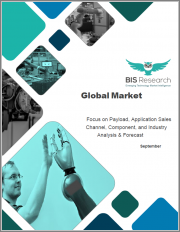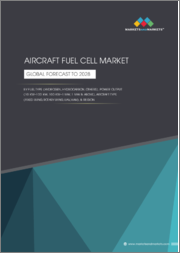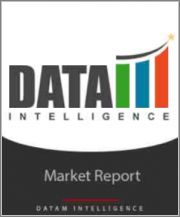
|
시장보고서
상품코드
1333877
세계의 항공우주 및 방위 분야용 연료전지 시장 : 현황 분석 및 예측(2022-2030년)Fuel Cells in Aerospace and Defense Market: Current Analysis and Forecast (2022-2030) |
||||||
항공우주 및 방위 분야용 연료전지(Fuel Cells in Aerospace and Defense) 시장은 비전통적인 에너지원의 수요 증가와 군·방위 분야 연료전지 채택 확대로 약 31%의 급성장이 전망되고 있습니다. 시장의 주요 기업은 첨단 엔진을 준비하기 위해 기술적으로 고급 기능을 갖춘 군 및 방위 용도의 연료 전지를 제공합니다. 예를 들어 2022년 11월, Airbus는 최초의 메가와트급 수소 연료 전지 엔진의 비행 시험 실증기를 준비했습니다.
제품에 따라 시장은 고체 산화물 연료 전지(SOFC)와 고체 고분자 연료 전지(PEMFC)로 이분됩니다. 고체 고분자 연료전지(PEMFC) 카테고리는 예측 기간 중 큰 CAGR로 성장할 것으로 예상됩니다. 이는 주로 SOFC보다 PMEFC 쪽이 열 관리가 뛰어나고, 플랜트 밸런스가 가벼운 것, 스택의 수명이 짧고, 통합의 유연성이 제한되어 있기 때문입니다. 또한 PEMFC는 효율, 컴팩트, 온도 범위, 수명에 따라 운송 용도에서 널리 사용됩니다.
용도별로 보면 항공우주 및 방위 분야용 연료전지 시장은 민간항공기와 회전익 항공기로 이분됩니다. 회전익 항공기 카테고리는 예측 기간 중 큰 CAGR로 성장할 것으로 예상됩니다. 헬리콥터나 수직 이착륙기 등 회전익기는 항공우주·방위산업에서 매우 선호되고 있습니다. 또한 연료 전지는 조용하고 효율적인 전원을 제공하기 때문에 회전익 항공기에 중요합니다. 회전익기는 고출력을 필요로 하고 소음의 배출을 억제할 수 있기 때문입니다. 또한 연료전지는 다른 동력원에 비해 보다 긴 내구성, 후방지원 절감, 운영비용 절감을 실현합니다.
항공우주 및 방위 분야용 연료전지 산업의 시장 도입에 대한 이해를 깊게 하기 위해 시장은 북미(미국, 캐나다, 기타 북미 지역), 유럽(독일, 영국, 프랑스, 스페인, 이탈리아, 기타 유럽 지역), 아시아 태평양(중국, 인도, 일본 및 기타 아시아 태평양) 및 기타 국가와 같은 전 세계 국가에서의 입지를 기반으로 분석됩니다. 북미는 예측 기간 중 상당한 CAGR로 성장할 것으로 예측됩니다. 이는 주로 연료전지 발전의 수요가 높고, 이 지역에서 수소생성의 연구개발이 증가하고 있는 것이 시장 성장을 촉진하고 있기 때문입니다. 또한 북미에는 Boeing, Lockheed Martin, Northrop Grumman을 비롯한 세계 최대급의 항공우주·방위기업이 있으며, 이들 기업은 최근 연료전지 기술에 많은 투자를 하고 있습니다. 이후 이러한 기업은 항공기 및 기타 용도의 연료전지 시스템 개발 및 시험의 최전선에 서서 이 기술에 대한 지속적인 투자가 시장 성장을 이끌고 있습니다. 예를 들어 2021년 8월, 하니웰의 경량 드론용 신기술은 보다 깨끗하고 조용한 수소 연료 전지로 항속 거리를 3배로 늘렸습니다. 또한 북미에는 연료전지를 탑재한 UAV 및 기타 무인 시스템을 적극적으로 개발·배치하고 있는 미군이 있으며, 이 지역의 시장 성장을 지원하고 있습니다.
목차
제1장 시장 소개
- 시장 정의
- 주요 목적
- 이해관계자
- 제한 사항
제2장 조사 방법 또는 전제
- 조사 프로세스
- 조사 방법
- 응답자 개요
제3장 시장 요약
제4장 주요 요약
제5장 COVID-19가 항공우주 및 방위 분야용 연료전지 시장에 미치는 영향
제6장 항공우주 및 방위 분야용 연료전지 시장 매출(2020-2030년)
제7장 제품별 시장 인사이트
- 고체 산화물형 연료 전지(SOFC)
- 고체 고분자형 연료 전지(PEMFC)
제8장 용도별 시장 인사이트
- 민간 항공기
- 회전익 항공기
제9장 지역별 시장 인사이트
- 북미
- 미국
- 캐나다
- 기타 북미 지역
- 유럽
- 독일
- 영국
- 프랑스
- 스페인
- 이탈리아
- 기타 유럽 지역
- 아시아 태평양
- 중국
- 인도
- 일본
- 호주
- 기타 아시아 태평양
- 기타 세계 지역
제10장 항공우주 및 방위 분야용 연료전지 시장 역학
- 시장 촉진 요인
- 시장이 해결해야 할 과제
- 영향 분석
제11장 항공우주 및 방위 분야용 연료전지 시장 기회
제12장 항공우주 및 방위 분야용 연료전지 시장 동향
제13장 수요 및 공급측 분석
- 수요측 분석
- 공급측 분석
제14장 밸류체인 분석
제15장 가격 분석
제16장 전략적 인사이트
제17장 경쟁 시나리오
- 경쟁 상황
- Porter's Five Forces 분석
제18장 기업 개요
- Advent Technologies
- ElringKlinger AG
- Australian Fuel Cells Pty Ltd
- Honeywell International Inc.
- Infinity Fuel Cell and Hydrogen, Inc.,
- Loop Energy Inc.
- Intelligent Energy Limited
- Plug Power Inc.
- Cummins Inc
- GenCell Ltd
제19장 면책사항
LYJ 23.09.06A fuel cell is a very effective power source. It is commonly defined as an electrochemical device that converts the supplied fuel to electric energy and heat continuously if reactants are supplied to its electrodes. Fuel cells are one of the fastest growing alternative energy resources due to their ability to convert electricity through a variety of fuels. Additionally, fuel cells are conventional resources which are eco-friendly, as their by-products do not harm nature. Due to such factors, they are highly used in the market of aerospace and defence across the globe. For instance, in Mar 2021, Fuel Cell Technology for Larger Aircraft Could Lower Emissions. The aerospace industry has proven it can utilize fuel cells for small aircraft.
The Fuel Cells in Aerospace and Defense Market is expected to grow at a skyrocket rate of around 31% owing to the rising demand from non-conventional energy sources coupled with the growing adoption of fuel cells in military & defense sectors. Major companies in the market offer fuel cells for military and defense applications with technologically advanced features to prepare more advance engines. For instance, in Nov 2022, Airbus prepared for its first megawatt-class hydrogen fuel-cell engine flight-test demonstrator.
Based on product, the market is bifurcated into Solid-Oxide Fuel Cell (SOFC) and Proton Exchange Membrane Fuel Cells (PEMFC). Proton Exchange Membrane Fuel Cells (PEMFC) category is expected to grow with a significant CAGR during the forecast period. This is mainly owing to better thermal management, the lighter balance of plant, shorter stack service life, and limited integration flexibility of PMEFC over SOFC. In addition, PEMFC is widely used for transportation applications due to its efficiency, compactness, temperature range, and lifetime.
Based on application, the fuel cells in aerospace and defense market have been bifurcated into civil aviation and rotorcraft. The rotorcraft category is expected to grow with a significant CAGR during the forecast period. Rotorcraft such as helicopters, and vertical takeoff and landing aircrafts are highly preferred in the aerospace and defense industry. Additionally, fuel cells provide a quiet and efficient power source and that is major for rotorcraft. Since they require high power output and reduce noise emissions. Also, fuel cells provide longer endurance, reduced logistical support, and lower operating costs compared to other power sources.
For a better understanding of the market adoption of the fuel cells in aerospace and defense industry, the market is analyzed based on its worldwide presence in the countries such as North America (U.S., Canada, Rest of North America), Europe (Germany, U.K., France, Spain, Italy, Rest of Europe), Asia-Pacific (China, India, Japan, Rest of Asia-Pacific), Rest of World. North America is anticipated to grow at a substantial CAGR during the forecast period. This is mainly attributed to the high demand for fuel cell power generation, as well as increasing research and development for hydrogen generation in the region is driving the growth of the market. Moreover, North America has one of the world's largest aerospace and defense companies, including Boeing, Lockheed Martin, and Northrop Grumman, all of which have invested heavily in fuel cell technology in recent years. Since, these companies have been at the forefront of developing and testing fuel cell systems for aircraft and other applications, and their continued investment in this technology is driving market growth. For instance, in Aug 2021, New Honeywell Technology for Light Drones Increased Range Threefold with Cleaner, Quieter Hydrogen Fuel Cells. Additionally, North America has US military that are actively developing and deploying fuel cell-powered UAVs and other unmanned systems, which has helped to drive market growth in this region.
Some of the major players operating in the market include: Advent Technologies; ElringKlinger AG; Australian Fuel Cells Pty Ltd; Honeywell International Inc.; Infinity Fuel Cell and Hydrogen, Inc.; Loop Energy Inc.; Intelligent Energy Limited; Plug Power Inc.; Cummins Inc; GenCell Ltd.
TABLE OF CONTENTS
1 MARKET INTRODUCTION
- 1.1. Market Definitions
- 1.2. Main Objective
- 1.3. Stakeholders
- 1.4. Limitation
2 RESEARCH METHODOLOGY OR ASSUMPTION
- 2.1. Research Process of the Fuel Cells in Aerospace and Defense Market
- 2.2. Research Methodology of the Fuel Cells in Aerospace and Defense Market
- 2.3. Respondent Profile
3 MARKET SYNOPSIS
4 EXECUTIVE SUMMARY
5 IMPACT OF COVID-19 ON THE FUEL CELLS IN AEROSPACE AND DEFENSE MARKET
6 FUEL CELLS IN AEROSPACE AND DEFENSE MARKET REVENUE, 2020-2030F
7 MARKET INSIGHTS BY PRODUCT
- 7.1. Solid-Oxide Fuel Cell (SOFC)
- 7.2. Proton Exchange Membrane Fuel Cells (PEMFC)
8 MARKET INSIGHTS BY APPLICATION
- 8.1. Civil Aviation
- 8.2. Rotorcraft
9 MARKET INSIGHTS BY REGION
- 9.1. North America
- 9.1.1. U.S.
- 9.1.2. Canada
- 9.1.3. Rest of North America
- 9.2. Europe
- 9.2.1. Germany
- 9.2.2. U.K.
- 9.2.3. France
- 9.2.4. Spain
- 9.2.5. Italy
- 9.2.6. Rest of Europe
- 9.3. Asia-Pacific
- 9.3.1. China
- 9.3.2. India
- 9.3.3. Japan
- 9.3.4. Australia
- 9.3.5. Rest of Asia-Pacific
- 9.4. Rest of World
10 FUEL CELLS IN AEROSPACE AND DEFENSE MARKET DYNAMICS
- 10.1. Market Drivers
- 10.2. Market Challenges
- 10.3. Impact Analysis
11 FUEL CELLS IN AEROSPACE AND DEFENSE MARKET OPPORTUNITIES
12 FUEL CELLS IN AEROSPACE AND DEFENSE MARKET TRENDS
13 DEMAND AND SUPPLY-SIDE ANALYSIS
- 13.1. Demand Side Analysis
- 13.2. Supply Side Analysis
14 VALUE CHAIN ANALYSIS
15 PRICING ANALYSIS
16 STRATEGIC INSIGHTS
17 COMPETITIVE SCENARIO
- 17.1. Competitive Landscape
- 17.1.1. Porters Fiver Forces Analysis
18 COMPANY PROFILED
- 18.1. Advent Technologies
- 18.2. ElringKlinger AG
- 18.3. Australian Fuel Cells Pty Ltd
- 18.4. Honeywell International Inc.
- 18.5. Infinity Fuel Cell and Hydrogen, Inc.,
- 18.6. Loop Energy Inc.
- 18.7. Intelligent Energy Limited
- 18.8. Plug Power Inc.
- 18.9. Cummins Inc
- 18.10. GenCell Ltd














